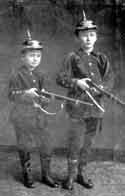
|
|
Not Old Enough - yet?
German children playing soldier.
Picture made in 1914. The boy on the left definitely is too young, but his brother will be wanted for the German army in the next years.
Photograph taken from Krieg dem Kriege (1924), the famous anti-war book by Ernst Friedrich.
Pictures of children playing war are abundant in all countries in this period (see here an example from England, here one from Belgium and here one from France). Unfortunately the Great War gave many of them a chance to revert play to reality.
|

|
|
German Recruits
This picture is probably made in 1917.
Because of a higher birthrate Germany had more boys at her disposal than other countries. That's why the Germans were able to increase their armies until the spring of 1918.
|
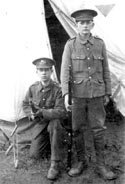
|
|
British Recruits
Young soldiers of the Lancaster Regiment outside a bell tent in a trainingcamp.
|

|
|
Young French Recruits-to-be
In France the enthousiasm to join was enormous too. The picture shows young Frenchmen on their way to the recruiting office.
Quote from the British weekly The War Illustrated on 28th May, 1915, describing a battle near La Bassée:
"Two French battalions of the line headed the charge, mostly formed of the youngest recruits. The Bavarians held their ground and fought gamely. The youngest soldiers of France rushed the machine-guns, at no matter what loss, emptied their magazines into the crowded trenches, and then jumped in and fought with the bayonet."
|

|
|
Eager for War
Eton boys ready for war.
The story goes that under-age youths wishing to enlist during the war used to write the number eighteen on a piece of paper placed into the sole of their shoe. This was done in order to deceive the enrollment officer when asked if they were over 18...
The British army resisted any suggestion that recruits prove their age by producing their birth certificates when enlisting. It was a scandal which provoked complaints in Parliament. The National Service League also protested, claiming that around 15% of wartime recruits were underage.
The army eventually allowed underage soldiers to be reclaimed by their parents.
  According to populair belief the youngest boy to enlist in the allied armies was John Condon from Waterford, Ireland. He was supposedly 12 years old. According to populair belief the youngest boy to enlist in the allied armies was John Condon from Waterford, Ireland. He was supposedly 12 years old.
In 1915 John Condon went with the Royal Irish Regiment to Flanders. He died on 24th May 1915, during a German gas-attack near Ypres. His gravestone (picture on the right), nr. 6322 at the Poelkapelle British Cemetery in Belgium, mentions his age as 14.
 Investigations in 2002 by Aurel Sercu from Ypres, Flanders, revealed that someone else may be buried in John Condon's grave. Sercu also found indications that John Condon was in fact 18 years old. Investigations in 2002 by Aurel Sercu from Ypres, Flanders, revealed that someone else may be buried in John Condon's grave. Sercu also found indications that John Condon was in fact 18 years old.
|

|
|
Decorated
Nowadays we look different upon kid-soldiers than we did during that war.
This picture shows a French corporal proudly posing for the camera. French and allied newspapers brought the picture and without any reserve told the public that the boy had joined the army when he was 14 years old, that he was wounded and that he had won the French Cross of War.
|
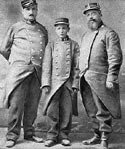
|
|
Little Blue
Another example of how newspapers and magazines presented young boys as fullgrown warriors.
The boy in the middle is '15 years old hero' Edouard Mina from Lyon, France.
Edouard is an orphan. His 'adoption-parents' next to him call him Petite Bleu, little blue, because of his blue pants that every French poilu (common soldier) wears.
|

|
|
Ship Boy
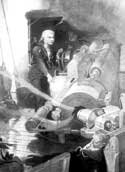 England found a boy hero in Jack Cornwall, ship boy on board of the light cruiser HMS Chester, where he served as a sight-setter. England found a boy hero in Jack Cornwall, ship boy on board of the light cruiser HMS Chester, where he served as a sight-setter.
During the Battle of Jutland in June 1916 the Chester was hit and put afire by German shells. In the chaos one gun kept firing at the Germans. It was manned by Jack Cornwall, aged 16 years and 4 months.
Jack was mortually wounded but kept on firing until he died. He was posthumously awarded the Victoria Cross.
Newspapers and magazines took possession of the boy. See the drawing on the right.
|
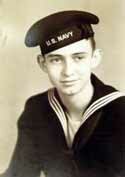
|
|
American and Underage
Young American sailor.
In the USA enlisting of underage boys was an old custom. It went on until the early fifties of the last century.
The USA is the only country where an association called Veterans of Underage Military Service exists. The VUMS was formed in 1991.
|
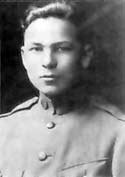
|
|
He is very old now
... and still going strong.
Frank Woodruff Buckles enlisted in the American army at age 16 in 1917. He is still alive and one of the oldest veterans in the world.
During his summer vacation from school he went to the Marine Corps recruiting office to enlist, told them he was 21, but he was turned down: too small. He tried the Navy: too flatfooted.
He then went to the Army and they accepted him. "The old sergeant advised me that the Ambulance Service was the quickest way to get to France because the French were begging for ambulance services".
In France he served at several locations. After Armistice Day he was assigned to a prisoner-of-war escort company to return prisoners back to Germany.
In World War II, while working for a steamship company in the Philippine Islands, the Japanese army seized him and he stayed in a prisoner-of-war camp for more than three years.
|
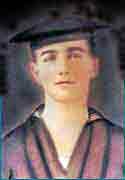
|
|
From Kid-Soldier To Senator
American Senator Mike Mansfield was a kid-soldier from the Great War.
Mansfield was a son of Irish immigrants. In 1917, fourteen years old, he quit school and tried to enlist in the armed forces, but he was turned down.
He then went to the Catholic church where he had been baptized, obtained a copy of his birth certificate, and forged it to show that he was born a few years earlier.
With these papers he was accepted in the Navy and he crossed the Atlantic seven times before officers discovered he was underage and discharged him.
After the war he worked in copper mines. Then, at the instigation of his wife (who was a teacher), he took high school. Then followed university. He became a professor in Far Eastern history and went into politics.
He served 34 years in Congress, 24 of those in the Senate (Democrats).
Michael Joseph Mansfield died on 5 October 2001. He was 98 years old. He never told much about his time in the war.
|

|
|
From Kid-Soldier To King
Crownprince Leopold of Belgium, 14 years old.
On April 5, 1915, Leopold — 13 years old at that time — joined the Belgian Twelfth Line Regiment.
King Albert introduced the boy to his fellow-soldiers on the Northsea beach of De Panne. The king said he did not want any preferential treatment for his son. "Let hem work in the trenches. He has to know how it feels to have blisters on his hands."
Obviously the main reason for the king to send the crownprince into the army was to stir up the national sense of duty. The largest part of Belgium was occupied by German forces and many Belgians collaborated.
One month later, in May 1915, the young soldier already served in the frontline. Shells exploded in his trench, but he was not harmed.
|

|
|
Place Fillers
Although every country had underage solders in their army, the propaganda often used enemy boy soldiers to prove how weak the foe was. This picture of captured German soldiers was published in America (in Leslie's Weekly) with the following caption:
Boy Prisoners Taken By The French - It has been said wars are fought by boys and military experts agree that the best soldiers are men in their early twenties, but a glance at these youthful prisoners convinces one that Germany is drawing soldiers from among the fifteen and sixteen year old boys of the empire to fill the places of the thousands of older men killed or captured.
Official picture of the French War Office.
|

|
|
More Place Fillers
More German Prisoners-Of-War, captured by the French during the Battle of the Aisne, in the last phase of the war.
The picture was published in France with the following byline:
Ces très jeunes Allemands prisonniers surprennent les soldats français
Translation: These very young German prisoners surprised the French soldiers.
|
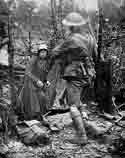
|
|
Surrender
Famous picture of the surrender of a young German soldier.
The boy climbs out of his shelter and gives himself up to a Scotch soldier.
|
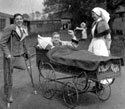
|
|
Crippled
Young disabled soldiers at the Fourth London General Hospital.
A child - so wasted and so white. The British nurse Eva Dobell wrote poems on some of her patients. One poem in particular - Pluck - is about a young soldier, crippled, 17 years old.
Click the picture to read that poem.
|

|
|
Dead in a Trench
Left: boy-soldier who met death in a flooded trench.
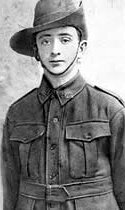 Even today romantic stories go around about young soldiers in the Great War. An example is the recent novel 'Soldier Boy', written by the Australian journalist Anthony Hill. Even today romantic stories go around about young soldiers in the Great War. An example is the recent novel 'Soldier Boy', written by the Australian journalist Anthony Hill.
Subject of this book is the short life of private Jim Martin (right), at 14 officially the youngest Australian serviceman to die at Gallipoli, Turkey.
As so many others the boy fibbed about his age to join up. When Jim's father was rejected for military service, the 5'6" lad said: "Never mind dad, I'll go instead". He told the recruiting officers that he was 18.
Jim landed with his battalion on Gallipoli on 8 September. He wrote to his family that the Turks are "still about 70 yards away from us" and asked them not to worry about him, "as I am doing splendid over here". But on 25 October he was evacuated to an hospital ship suffering from typhoid fever caught in the trenches. He died of heart failure that evening.
  Alec Campbell (right) was another Australian boy who lied about his age. He enlisted as a 16-year-old. "In those days if you were big enough you were good enough", he recalled later. "They didn't really care about your age." Alec Campbell (right) was another Australian boy who lied about his age. He enlisted as a 16-year-old. "In those days if you were big enough you were good enough", he recalled later. "They didn't really care about your age."
Alec too fought in Turkey, where his comrades nicknamed him The Kid. He remembered an "incredible hail of bullets" on landing at Gallipoli, where he was set to work ferrying water in the trenches, sleeping in a "cold, damp hole in the ground". Six weeks later he was too sick with enteric fever to fight and he was invalided home.
Alec Campbell died in Hobart, Australia, on 16 May 2002. He was 103 years old.
|
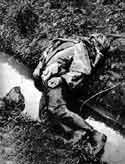
|
|
Miserable
Left: Boy-soldier lying dead in a ditch.
Siegfried Sassoon wrote: "As I stepped over one of the Germans an impulse made me lift him up from the miserable ditch. Propped against the bank, his blond face was undisfigured, except by the mud which I wiped from his eyes and mouth with my coat sleeve. He didn`t look to be more than eighteen. Hoisting him a little higher, I thought what a gentle face he had." (in Memoirs from an Infantry Officer)
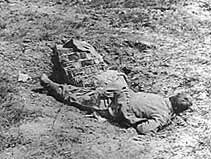  Pictures of dead kid-soldiers could be made anywhere, on any battlefield, such as on the Eastern Front (right). Pictures of dead kid-soldiers could be made anywhere, on any battlefield, such as on the Eastern Front (right).
"In Russia there is scarcely a town or school from which boys have not run away to the war", Stephen Graham wrote after travelling through that country in 1916-1917.
He added: "Hundreds of Russian girls have gone off in boy`s clothes and tried to pass themselves off as boys and enlist as volunteers. And several have got through, since the medical examination is only a negligible formality required in one place, forgotten in another; the Russians are so fit as a whole."
"So among the wounded in the battle of the Nieman was a broad-shouldered, vigorous girl from Zlato-Ust, only 16 years old, and nobody had dreamed that she was other than the man whom she was passing herself off."
"But not only Russian boys and girls of sixteen and seventeen, but also children of eleven and twelve have contrived to have a hand either in the fighting or in the nursing", Graham observed.
|
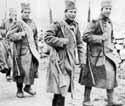
|
|
Flight Towards Death
About 23,000 Serbian boys found death during their flight out of Serbia in the terrible winter of 1915.
To prevent falling in the hands of the German/Austrian and Bulgarian enemies the Serbian leaders ordered their armies and 30,000 civilian boys to leave the country.
These boys, soldiers-to-be indeed, were between 12 and 18 years old and the majority of them could not stand the cold, the hunger and the hardship of the journey (and the enduring attacks by Albanese raiders).
Fifteen thousand boys died in the Prokletije, the Cursed Mountains of Kosovo, Montenegro and Albania. Those who finally made it to the Adriatic Sea did not look human anymore.
In Avalona the Italians had insufficient food and lodging for them. When ships arrived to bring the kids to the Greek island of Corfu there were only 9,000 boys left. Another 2,000 died during the 24 hours journey from Avalona to Corfu.
Once on Corfu, a hundred boys died each day of lack of food. The survivors of this incomprehensible saga were sent to England and France.
|

|
|
Ready to Go
German mother smarts up her boy, who is ready to go to war.
Picture taken from Krieg dem Kriege (1924), the anti war book by Ernst Friedrich in which he addresses those responsible for "inspiring and preparing children for mass-murder".
|

|
|
Ready to March
German soldier boy, ready to march.
About 15% of Germany's volunteers were students and high school graduates. Entire lecture-rooms and classes - together with professors and teachers - would take themselves down to the recruiting offices.
In 1914 during the 1st Battle of Ypres, the German Army hurled many units of these enthusiastic but untrained students into the fray. They were shot down in thousands by the only professional Army in Europe - the British.
|
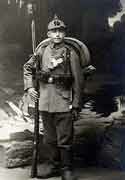
|
|
Ready to Die
German soldier boy. Looking at his face one could say that he seems devoted to his task.
|
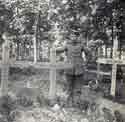
|
|
Still Alive
Young German soldier standing at the grave of his comrade.
Many of these boy soldiers are buried near Ypres, at the German war cemetery at Langemark. For this reason the place is known as the Studentenfriedhof - the Students Cemetery.
There are 44,292 German soldiers buried here. The cemetery also holds a mass grave, where roughly 25,000 soldiers lie.
|

|
|
Among Comrades
Typical soldiers snapshot. A group of German soldiers. Among them some who are quite young.
|

|
|
Guard
German soldier boy guarding Australian prisoners-of-war.
Picture made in the German POW-camp in Münster, 1918.
|
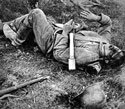
|
|
Stiffened
A young German soldier, stiffened in death. At his side an unused handgrenade, his rifle and his helmet.
During the Battle of the Somme, in the summer of 1916, British war correspondent Philip Gibbs noticed: "Some of the German dead were young boys, too young to be killed for old men's crimes, and others might have been old or young. One could not tell because they had no faces, and were just masses of raw flesh in rags of uniforms".
|
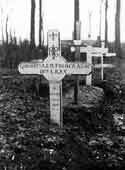
|
|
Wooden Cross, No Age
The original grave of Albert French, who died in 1916, in Belgium.
The wooden cross bears no age - and the official stone that marked his place on a later war cemetery did not either. Albert was 16 years old.
He was born on 22nd June, 1899 in Wolverton. In the summer of 1915, he went to a Recruiting Ofice in a nearby town and told them he was 18, the minimum age for enlistment.
 In the army he had his picture taken (right) and he send it home with a letter: "My mate said I looked about 14, and not much like a soldier. I shan't be a real soldier for another 2 or 3 years, I am only training for one yet awhile...". In the army he had his picture taken (right) and he send it home with a letter: "My mate said I looked about 14, and not much like a soldier. I shan't be a real soldier for another 2 or 3 years, I am only training for one yet awhile...".
But he was not allowed to live these extra years. Shortly after his arrival in Belgium, he wrote home: "We shall be popping away at the Germans pretty shortly, and as long as I don't get popped it will be alright, I guess..."
And to his sister he wrote: "The shells do not make so much row as I thought they would. They make a whirling, tearing noise and scream slightly. You can hear them rush through the air, but you can't see them going. They make a big hole and plenty of smoke when they burst, and bits fly about 50 yards. The bullets make a long, drawn out pinging noise."
He was killed soon after, on 15th June 1916 - a week before his 17th birthday. His commander wrote to his parents: "He was a very good soldier, although so young, and a willing worker, who made many friends in the company".
 In 1980, in an English Radio Documentary entitled He Shouldn't Have Been There, Should He?, Albert's brother George remarked that he had visited Albert's grave and that it had been the only grave he had seen without the age of death on it. In 1980, in an English Radio Documentary entitled He Shouldn't Have Been There, Should He?, Albert's brother George remarked that he had visited Albert's grave and that it had been the only grave he had seen without the age of death on it.
An official at the Commonwealth War Graves Commission heard the programme and offered to rectify the omission. Albert's grave now bears the legend "Age 16".
|

|
|
To the Trenches
Young and old together, on their way to the trenches.
The picture shows soldiers of the 10th Battalion of the Royal British Fusiliers.
Before the war the vast majority of working class adolescents in England left school at 14 to find manual work or to take up apprenticeships. The boys at the public schools belonged to a privileged few, who continued education until they were 18 or 21.
|
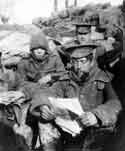
|
|
In the Trenches
Young and old together, in the trenches.
The effect of the war in the trenches on youngsters by weeks and months was often devastating.
"I've noticed that boys under twenty stood it worst, especially when the weather was bad. Mud and boredom and discomfort seemed to take all the guts out of them", Second Lieutenant S. Sassoon wrote.
|
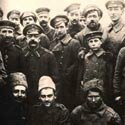
|
|
With Pride
Look at him, in the second row. He wears the uniform with pride, but how old is he?
German soldiers. In the foreground Russian prisoners-of-war.
|

|
|
Dead Brit
In England and in Scotland too whole public school classes went cheerfully to the Recruiting Offices.
These boys often served together in the same units.
The consequence was that when such a unit was ordered to attack, many or all contemporaries of a certain school, could die.
This happened at the Somme and in Flanders, where this picture was made.
|

|
|
More Dead Boys
French boys, fallen between the brushwood.
 France became burial-ground for youngsters of many nationalities. One of the most famous kid-soldiers who died here was John Kipling, son of the British 'national' poet Rudyard Kipling. France became burial-ground for youngsters of many nationalities. One of the most famous kid-soldiers who died here was John Kipling, son of the British 'national' poet Rudyard Kipling.
 Kipling had encouraged John (right), his only son, to enlist at the age of 16 even though the boy suffered from very poor eyesight. While his father rallied to the war effort with fiery poems exhorting the nation to "stand up and take the war", John went alone to a London recruiting station to volunteer for a commission in Lord Kitchener’s Volunteers. But his application was rejected on medical grounds. Kipling had encouraged John (right), his only son, to enlist at the age of 16 even though the boy suffered from very poor eyesight. While his father rallied to the war effort with fiery poems exhorting the nation to "stand up and take the war", John went alone to a London recruiting station to volunteer for a commission in Lord Kitchener’s Volunteers. But his application was rejected on medical grounds.
Determined, John tried to become a humble Private instead. Kipling then decided to take matters into his own hands and pulled some strings. The Commander in Chief, Lord Roberts, agreed to turn a blind eye to John's disablity, and to "rather overlook the calendar". The boy became a Second Lieutenant in the Second Battalion of the Irish Guards.
After Kipling received a telegram from the War office saying that John, in his first action, was Missing presumed Killed, he and his wife made countless journeys to French hospitals, speaking to soldiers who might have fought alongside John, or have any news of him.
The tragic loss led Kipling to change from being the bellicose poet of the Empire, to the poet of bitterness and guilt.
It was then that he wrote this couplet:
If any ask us why we died
Tell them, Because our fathers lied
|
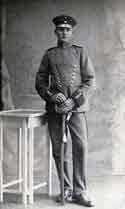
|
|
Sword Bearer
German Uhlan with his sword.
Uhlans were members of cavalry units.
|

|
|
Unexpected Help
An American Army chaplain helps a young German prisoner-of-war.
As Germany in 1918 ran out of cannon fodder, they had to commit very young soldiers to battle.
|

|
|
Executed
This is the gravestone of Herbert Morris, a black war-volunteer, executed by his own troops.
Morris enlisted in Jamaica when he was 16 years old. He was shipped to the battlefields in Flanders where, according to his superiors, he 'behaved well'. A year later, building parapets around heavy guns which were firing continuously, his nerves broke down. He ran for two days. Then he was arrested.
He was sentenced to be shot at dawn, because of 'desertion from active service near the frontline'.
Herbert Morris was executed, in a coal-shed in the Belgian village of Poperinge, on 20 September 1917. He had just turned 17.
 Being a kid was no excuse whatsoever. James Crozier from Belfast enlisted when he was 16. The boy became infatuated during the battle of the Somme, ran away and got arrested. A few hours before he was to be 'shot at dawn', his comrades gave him so much rum that he passed out. Being a kid was no excuse whatsoever. James Crozier from Belfast enlisted when he was 16. The boy became infatuated during the battle of the Somme, ran away and got arrested. A few hours before he was to be 'shot at dawn', his comrades gave him so much rum that he passed out.
James had to be carried to the execution place. Hij was tied to a pole, blindfolded and shot - but the firing-squad missed on purpose. The commanding officer then shot the boy through the head.
 Until the present day the British War Office, and today's Ministry of Defence, maintain that soldiers who enlisted underage during the First World War, had only themselves to blame if their conduct caused them to be court martialled and sentenced to death. Until the present day the British War Office, and today's Ministry of Defence, maintain that soldiers who enlisted underage during the First World War, had only themselves to blame if their conduct caused them to be court martialled and sentenced to death.
Furthermore the MOD states that the contemporary age of criminal responsibility was 14 and that in civilian courts these young men could also have been sentenced to death for a capital offence.
|
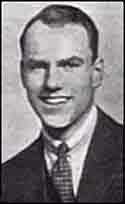
|
|
Executioner
Victor Silvester was born in 1900. On the outbreak of the war he ran away from Ardingly College and he was fighting on the Western Front at fifteen. Victor's parents suspected he had joined the army and informed the authorities in 1914 but it was not until he was wounded in 1917 that he was discovered and brought home to England
 In an interview he gave just before his death in 1978, Victor Silvester described how he was ordered to execute a man for desertion: In an interview he gave just before his death in 1978, Victor Silvester described how he was ordered to execute a man for desertion:
"The tears were rolling down my cheeks as the victim tried to free himself from the ropes attaching him to the chair. I aimed blindly and when the gunsmoke had cleared away we were further horrified to see that, although wounded, the man was still alive. Still blindfolded, he was attempting to make a run for it still strapped to the chair. An officer in charge stepped forward to put the finishing touch with a revolver held to the poor man's temple. He had only once cried out and that was when he shouted the one word 'mother'.
He could not have been much older than me. We were told later that he had in fact been suffering from shell-shock, a condition not recognised by the army at the time. Later I took part in four more such executions."
After the war Silvester became a world famous dance orchestra leader.
|

|
|
Electrocuted
Belgian boy who had tried to escape to the Netherlands.
The Germans who occupied Belgium had erected an electric fence on the border between occupied Belgium and the (neutral) Netherlands. They put 2,000 Volts on it, to prevent bordercrossing.
Nevertheless numerous refugees tried to get through. Many got electrocuted.
Many of the young Belgians who died here came from the occupied part of the country and were on their way to the free Belgian army. Because crossing the frontline through No Man's Land was not possible, they had to take a long detour, via the Netherlands (Holland). From there they could take a ship to England and then board another ship to France, from where they could travel back to free Belgium where their army continued fighting the Germans.
|
![]() Kid soldier in the Great War
Kid soldier in the Great War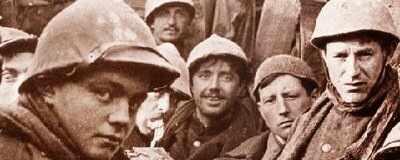 All armies in the Great War used kid soldiers. In the beginning of the war the enthousiasm to join the battle was so great that young boys (and even girls) could hardly be stopped to enlist.
All armies in the Great War used kid soldiers. In the beginning of the war the enthousiasm to join the battle was so great that young boys (and even girls) could hardly be stopped to enlist.![]() Click on one of the small photo's below - and you'll get the full picture.
Click on one of the small photo's below - and you'll get the full picture.




































![]() To the frontpage of The Heritage of the Great War
To the frontpage of The Heritage of the Great War